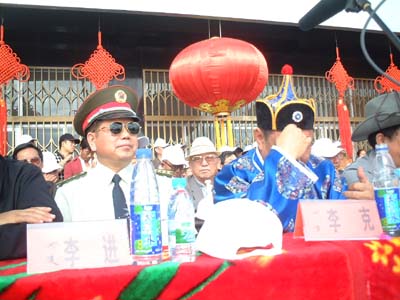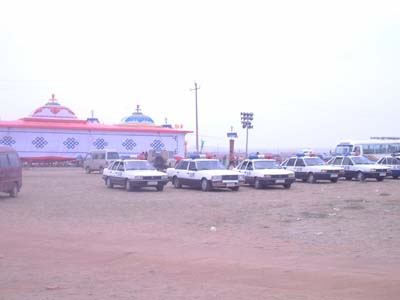| |
|
Southern Mongolian Human Rights Information Center |
|
December 17, 2003 |
|
New York |
|

|
|
Sandwiched between security personnel, a Mongolian official
of Bayannuur Aimag must speak in Chinese to the Mongols at the Mongolian traditional festival --- Naadam (photo from Bayannuur Aimag) |
|
|
|
|

|
Considered as the most sensitive gathering, Mongolian
traditional festival Naadam is tightly controlled by the
police in Inner Mongolia. (photo from Bayannuur Aimag)
|
|
According to China’s official news agency,
Xin Hua News, the Chinese State Department approved a bill
yesterday changing two ‘aimags’ (the geographical-administrative
units traditionally used in Mongolian areas translated as
“league”) of the Inner Mongolian Autonomous Region, Bayannuur
Aimag ( “Ba Yan Nuo Er Meng” in Chinese ) and Ulaanchav Aimag (
“Wu Lan Cha Bu Meng” in Chinese) into Chinese style
geographical-administrative units, called “shi” (translated as
"City") under the “quick urbanization of a backward region”
slogan.
Inner Mongolia has historically consisted of nine aimags, each
one composed of smaller geographical units known as Hushuus
(Banners). This traditional aimag-hushuu based administrative
system (designed to stop Han Chinese population transfer) had
been maintained for centuries as the mechanism for Mongolian
self-governing rights in Inner Mongolia even after the
occupation by the Chinese Communist Party regime in the region
and continued to serve an important symbolic meaning to
Mongolian identity.
However, since the 1980’s, in order to accelerate and
justify its population transfer and cultural assimilation, the
Chinese government started the process of converting Mongolian aimags to Chinese ‘shi’-s. Eastern Inner Mongolia’s Zuu-ud Aimag,
one of the most traditional aimags in the region, was changed to
Chifeng City without any consultation with the local Mongolian
people. After this “successful” administrative change, the
authorities continued to change many Hushuus (“Qi” in Chinese )
into counties (“Xian” in Chinese ) across the region. In 1999,
Eastern Inner Mongolia’s Jirim Aimag, home to the largest
Mongolian population among the nine aimags, was changed to Tong
Liao City under the direct instructions of the Central
Government, ignoring the local Mongolian people’s strong
protests.
In 2001, another aimag, Yeh-Zuu, which is considered one of the
most sacred and exemplary aimags in the region due to the
existence of the Chinggis Khaan Mausoleum and its history of
opposition to the Chinese regime, was changed to Ordos City. In
April 2002, the Central Government officially announced the
conversion of northeastern Inner Mongolia’s Huluun Boir Aimag
(believed to be the mythological land of Mongol origin) into a
city.
Including the recently converted two aimags, Bayannuur and
Ulaanchav, six out of nine historical aimags have been
officially converted to cities which are expected to be rapidly
“urbanized and modernized” by Han Chinese, including illiterate
peasants from neighboring provinces and unscrupulous businessmen
from coastal areas. Many ethnic Mongols believe that the
remaining three aimags, Shiliin-Gol, Alashaa, and Hingan, where
the traditional nomadic lifestyle has already been banned, will
undoubtedly be the next target of the “urbanization and
modernization” policy. Some worry that the Inner Mongolian
Autonomous Region will be changed to a province as the rights of
the Mongols as a minority are increasingly deprived by the
Central Government.
Related article:
From Yeke-juu League
to Ordos Municipality: settler colonialism and alter/native
urbanization in Inner Mongolia, by Uradyn E. Bulag |





